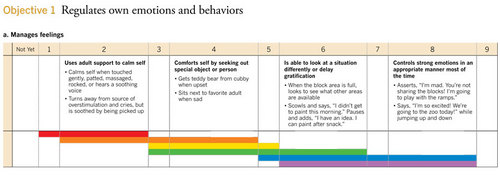Introduction
Assessing and evaluating children are critical in the educational process to measure children's learning and development. Assessment results can be used to guide classroom decision making, to identify children who might benefit from special services, and allow professionals to communicate with other adults about the children for whom they are responsible. Typically, assessment procedures are used as a part of program evaluations based on formal and informal, norm-referenced, and standardized assessments. Therefore, most of the assessment tools should be valid, reliable, free of bias, and culturally appropriate.
In the United States (U.S.), many assessment tools are available for young children such as BRIGANCE Early Childhood Developmental Inventory (BRIGANCE), Peabody Picture Vocabulary Test (PPVT-IV), Ages and Stages, Early Childhood Environment Rating Scale- Revised (ECERS-R), and Classroom Assessment Scoring System (CLASS) to name a few. These tools were developed in the eighties and nineties. However, with the current educational movements and initiatives, such as the enactment of Goals 2000: Educate America Act, the launch of new Early Childhood Learning Standards with emphasis on technology, school readiness initiatives, kindergarten screening efforts and statewide testing against academic benchmarks, some of these assessment tools do not address these requirements anymore. Furthermore, the dramatic increase in cultural and linguistic diversity among school children has produced a pressing need to improve assessment practices for young English language learners [ELLS] (Abedi & Gandara, 2007). According to The National Center for Education Statistics, the percentage of ELL in 2002-02 was 8.7%, and in 2011-12 it increased to 9.1% or an estimated 4.4 million students (2014). Teaching Strategies Curriculum GOLD is one of the assessment programs that possibly address this concern (Teaching Strategies GOLD, 2013).
Teaching Strategies GOLD®
Teaching Strategies GOLD® is an observational assessment system to evaluate children's development and learning from birth through kindergarten (Lambert, Kim & Burts, 2014). It is designed to help teachers discover what children know and can do as well as their strengths, needs, and interests (Heroman, Burts, Berke, & Bickart, 2010). "The assessment is grounded in 38 research-based objectives that include predictors of school success and are aligned with state early standards in the United States (emphasis added)" (Dodge, 2011, p.1). Teaching Strategies GOLD® covers diverse aspects of the curriculum and involves a range of activities.
The assessment may be implemented with any developmentally appropriate curriculum using either web-based or conventional systems. The system is widely used across the U.S. (Hyson, 2008) in Head Start child care centers, and school-based programs, such as Project HELP. In 2012 there were about 257,000 (approximately 80%) early care and education centers utilizing Teaching Strategies GOLD® Assessment System (National Association of Child Care Resource and Referral, 2014).
Teaching Strategies GOLD® is appropriate for children with disabilities, children who are English-language learners and children who demonstrate competencies beyond typical developmental expectations (Heroman, Burts, Berke, & Bickart, 2010). However, it is not intended to be used as a screening or diagnostic measure, an achievement test, or a program evaluation tool (Lambert, Kim & Burts, 2014).
The Components of Teaching Strategies GOLD®
Teaching Strategies GOLD® has four components: Objectives for Development and Learning, Child Assessment Portfolio, Assessment Opportunity Cards, and On-the-Spot Observation Recording Tool. Figure 1 provides a brief description of each component.
| Components | Descriptions | |
|---|---|---|
| 1 | Objectives for Development and learning | There are 38 objectives, organized into four areas of development and learning (social-emotional, physical, language, and cognitive) and six content learning standards (literacy, mathematics, science and technology, social studies, the arts, and English Language acquisition). |
| 2 | Child Assessment Portfolio | The portfolio is used to record and document assessment information over the course of a year. The portfolio can be in electronic form, a box, or binder. |
| 3 | Assessment Opportunity Cards | The assessment contains 10 selected activities that can be integrated into everyday classroom activities to help teachers focus on the observations and collect information related to particular objectives. The cards explain how to structure additional opportunities for children to demonstrate what they know and can do in relation to particular objective. |
| 4 | On-the-Spot Observation Recording Tool | The on-the-spot observation recording tool streamlines the overall process of recording information about physical development, literacy, and math skills. It is used when teachers need to date when a behavior or skill was observed for a particular objective. |
One of the features of the Teaching Strategies GOLD® assessment system is that each of the objectives has 9 rating scales that can be used to assign a value to the child's level in a particular progression. Rating 1 indicates the lowest and 9 is the highest score (see Figure 2 below). There is also a rating of "Not Yet" before rating 1, which can be used to indicate that the child has not yet achieved the observed learning objective. Color-coding is used to indicate the age or class/grade ranges for the expectations. The colors red, orange, and yellow code each year of life for the first three years; green, blue, and purple code classes/grades for the next three years. The ratings and color coding are very easy to use by the teachers to determine a child's level of development for each objective. The teacher can use this information to plan appropriate activities for the child. A sample list of the objectives for Social-Emotional, 1a: Regulates Own Emotions and Behaviors: Manages Feelings is shown in Figure 2 below.

Strengths and Limitations of the Assessment
Teaching Strategies GOLD® is convenient, practical, and efficient to use (Decker, 2013). It offers teachers the ability to create online portfolios and easily upload scans, photos, observation notes, and video clips. Teachers can capture photos, videos, audio clips, and text notes; tag documentation with objectives, dimensions, and children's names, and send data to Teaching Strategies GOLD®. It includes multimedia examples and is a simple way to document more than one aspect of a child's development and learning. With generous storage space for large files, teachers can upload a wide variety of documentation to support each child's developmental profile.
Teaching Strategies GOLD® also provides a free app, called Teaching Strategies GOLD® Documentation created exclusively for teachers using the Teaching Strategies GOLD® online assessment system. Using an online portal, families can access and contribute information about their child's learning and development as well. However, for locations where technology support and internet access are limited, using Teaching Strategies GOLD® can be a challenge for educators and families. Teachers have to use the paper and pencil version of the assessment and save the data in paper form as well. Nevertheless, teachers who use this option should consider the issues of time and cost that are involved in the process, and storage of the data.
The assessment guides teachers through the process of evaluating children's knowledge, skills, and behaviors. The color-coded progressions of development and learning make it easy for teachers to compare each child's knowledge, skills, and behaviors to widely held expectations for most children of the same age or class/grade. It also generates a comprehensive report and helps teachers make better decisions (Decker, 2013). It is important to note that this assessment only evaluates children's development and learning, not all areas of the quality of the learning program being used.
Teaching Strategies GOLD® is a criterion-based type of assessment that measures a child's performance against a predetermined set of criteria and yields performance profiles that reflect the child's skills at a certain developmental level and aspect. This type of assessment may be standardized but the developmental content usually allows flexibility in administrative procedures.
Teaching Strategies GOLD® assessment program can also serve as a resource for designing professional development activities for program administrators and staff as part of the implementation of early childhood best practices in early care and education. Early care and education in the U.S. are currently characterized by coordinated systems of service delivery, with assessment as a central component along with curriculum and program evaluation (National Association for the Education of Young Children & National Association of Early Childhood Specialists/in State Departments of Education, 2003). In addition, Teaching Strategies GOLD® also addresses the U.S. state and federal law early intervention program, called Recognition and Response (RaR). RaR is a preschool version of the Response of Intervention (RtI), a three-tier model of instruction to identify students who are not making expected progress in academic performance.
Teachers and parents acknowledge that Teaching Strategies GOLD® is easy to use and saves time and space. Children's information is well-organized and very informative. It informs parents and stakeholders about what the child can do or cannot do and it is easy to monitor progress in development and learning including that of children with disabilities. A study conducted by the research team from Teaching Strategy of over 400,000 prekindergarten children in 2013 revealed that children in classrooms where teachers used both The Creative Curriculum® for Preschool and Teaching Strategies GOLD® scored higher in language, cognitive skills, literacy, and mathematics than did children in classrooms where their teachers used a different curriculum (Teaching Strategy, 2013). This program has proved to be one of the best assessments for preschoolers in the USA.
-
References:
- Abedi, J., & Gandara, P. (2006). Performance of English language learners as a subgroup in large-scale assessment: Interaction of research and policy. Education Measurement: Issue and Practice, 25(4), 36-46
- Decker, C.G. (2013). Teaching Strategies GOLD: Testing reliability and validity using the Bracken School Readiness Assessment. Unpublished report of CAP Tulsa.
- Dogde, D.T (2011). Teaching strategies GOLD touring guide. Washington, DC: Teaching Strategies.
- Heroman, C., Burts,D.C., Berke, K., & Bickart, T. S. (2010). Teaching strategies GOLD objectives for development and learning. Washington, DC: Teaching Strategies.
- Hyson, M. (2008). Enthusiastic and engaged learners: Approaches to learning in the early childhood classroom. New York: Teachers College Press.
- Lambert, R. G., Kim, D., & Burts, D.C. (2014). Using teacher ratings to track the growth and development of young children using the Teaching Strategies GOLD® assessment system. Journal of Psychoeducational Assessment, 32(1), 27-39.
- National Association for the Education of Young Children & National Association of Early Childhood Specialists/in State Departments of Education (2003). Early childhood curriculum, assessment, and program evaluation: Building an effective, accountable system in programs for children birth through age 8. Washington, DC: National Association for the Education of Young Children.
- National Association of Child Care Resource and Referral (2014). Child care in America, 2013: State Fact sheet. Arlington, VA.
- Teaching Strategies GOLD (2013).Assessment system: Technical summary 2013. Washington, DC: Teaching Strategies.
- The National Center for Education Statistics (2014). English language learners. Retrieved from http://nces.ed.gov/programs/coe/indicator_cgf.asp



 Sham'ah Md-Yunus
Sham'ah Md-Yunus










